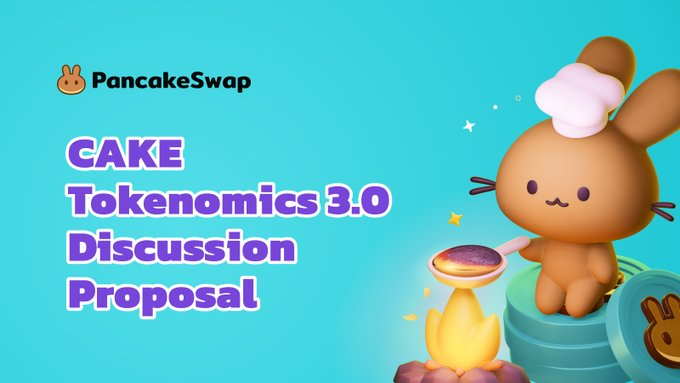PancakeSwap CAKE Tokenomics 3.0: The Logic and Challenges of the Deflationary Revolution
Recently, PancakeSwap announced the launch of CAKE tokenomics 3.0, a comprehensive overhaul of its token distribution and burn mechanisms. This marks the third economic model upgrade since PancakeSwap’s launch in 2021, directly targeting historical issues such as uncontrolled token inflation and dispersed liquidity. By reducing emissions, accelerating token burns, and simplifying rights rules, CAKE is transitioning from an “infinite supply” token to a scarce asset, thereby establishing a new value anchoring paradigm in the DeFi market.

Why the Upgrade Was Necessary: Historical Issues and Market Pressure
The initial design of CAKE tokens fueled rapid growth—high rewards through liquidity mining attracted users and helped PancakeSwap secure a 70% DEX market share on the BNB Chain in 2023. However, the model of infinite issuance eventually revealed significant drawbacks:
-
Inflationary Pressure:CAKE has long maintained an annual inflation rate above 12%, with a daily emission of around 40,000 tokens (roughly US$1.3 million), continually subjecting holders to selling pressure.
-
Declining Competitiveness:Competitors like Uniswap V4 leverage dynamic fees and tiered liquidity to attract large traders, while SushiSwap has enhanced governance token staking rewards. CAKE’s single mining model struggles to retain capital.
-
Inefficient Community Governance:The veCAKE (voting escrow) mechanism is complex and has a high participation threshold, leading to a proposal voting rate of under 15%.
The immediate trigger for this upgrade was the “token burn pilot” launched in August 2024. By March 2025, over 25 million CAKE tokens (valued at US$850 million) were burned, generating a short-term price rally of about 20%. This verified the deflation strategy’s effectiveness and prompted the team to upgrade the temporary measure into a systematic reform.
Core Upgrades of CAKE 3.0: Deflation, Simplification, and Cross-Chain Synergy
The new model focuses on three main objectives: reducing inflation, enhancing utility, and expanding cross-chain advantages. Specific measures include:
Supply Cap and Emission Reduction:
- Set a target to reduce the total supply by 20% by 2030, compressing the annual inflation rate from 12% down to 4%.
- Lower the daily emission from 40,000 to 22,500 tokens—a 43.75% reduction—to lessen market selling pressure.
Comprehensive Burn Mechanism:
- Transaction Fee Burns: Automatically burn 0.05% of each transaction fee in CAKE (projected to boost annual burn by 30%).
- Reinvestment of Ecosystem Revenue: Allocate 2% of revenues from the NFT marketplace and prediction services for token burns, forming a positive “income growth–burn acceleration” cycle.
Simplification of Token Rights:
- Eliminate the veCAKE staking and weighted voting mechanism, adopting a “hold-to-govern” model to lower participation barriers.
- Integrate cross-chain liquidity, allowing users to directly burn CAKE tokens on 12 chains—including BNB Chain, Polygon, and Base—to enhance cross-chain capital efficiency.
According to data from JuCoin Research Institute, following the implementation of the new model, the number of CAKE holder addresses grew by 18% within one week; however, among the top ten addresses, two whale accounts reduced their holdings by over 30%, reflecting short-term market concerns over the decreased yields from liquidity mining.
Market Impact: Price Volatility, Liquidity Migration, and Regulatory Risks
-
Retail Investor Confidence Rebounds:The deflationary narrative has attracted long-term investors, with addresses holding fewer than 10,000 tokens now accounting for 67% of the total.
-
Institutional Strategy Divergence:Some hedge funds are incorporating CAKE into their arbitrage portfolios, profiting from cross-chain price differentials (for instance, CAKE on the Base chain once traded at a 3% premium over that on the BNB Chain).
-
Liquidity Redistribution:While the total TVL on the BSC (BNB Chain) declined by 7%, TVL on Polygon and Base chains increased by 12%, indicating a buffering effect from the multi-chain strategy.
Nonetheless, potential risks remain:
-
Short-Term Liquidity Crisis:Reduced emissions could prompt small liquidity providers (LPs) to exit, increasing trading slippage.
-
Community Governance Conflict:Some veCAKE holders protest the removal of their rights, posing a risk of a network fork.
-
Regulatory Uncertainty:The Hong Kong Monetary Authority is studying the compliance of token burns on DeFi platforms; if such actions are deemed as “market manipulation,” legal risks may arise.
Future Outlook: From Token Reforms to DeFi Ecosystem Restructuring
If the CAKE 3.0 model operates successfully, it could trigger a chain reaction in the DeFi market:
Reshaping the Competitive Landscape:
Other DEXs such as Uniswap or Trader Joe may follow suit by launching their own deflationary models, accelerating industry reshuffling.
Integration with RWA (Real-World Assets):
PancakeSwap plans to allocate a portion of the burned tokens to purchase low-risk assets such as U.S. Treasuries, enhancing CAKE’s yield support.
Regulatory Collaboration Window:
A simplified economic model will be easier for regulators to understand, potentially paving the way for specialized DeFi legislation in regions like Hong Kong and Singapore.
For ordinary investors, CAKE 3.0 represents not only a technological upgrade but also a turning point in investment logic—shifting token value drivers from “mining output” to “actual demand.” Users can simulate long-term returns under different inflation scenarios to optimize their holding strategies.




